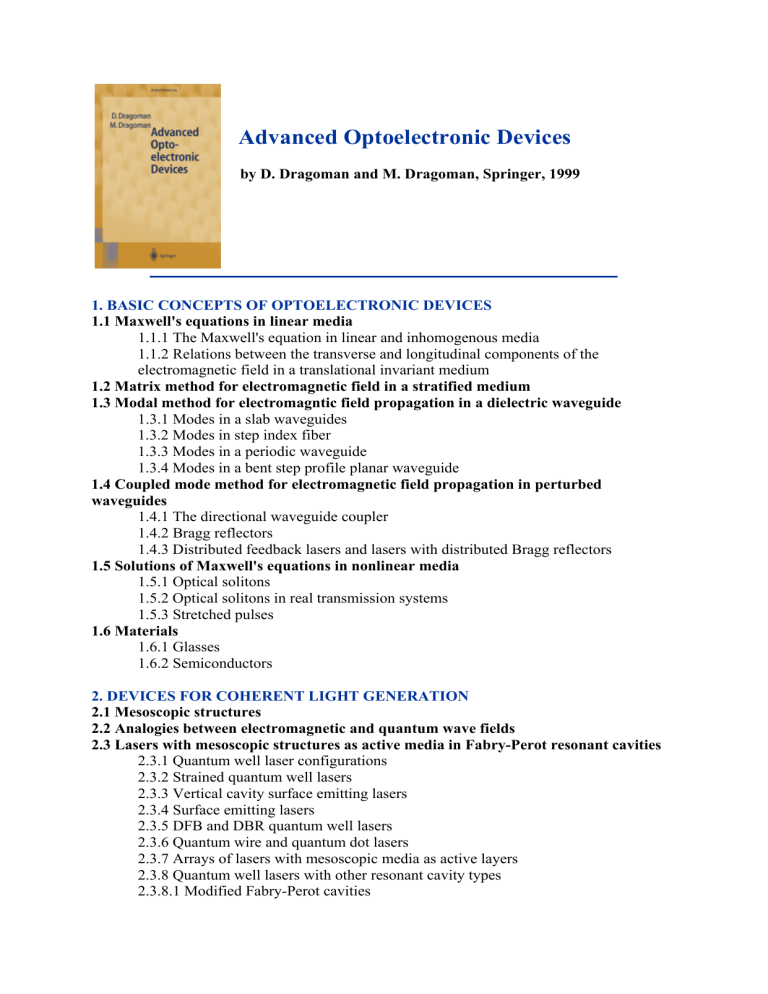Advanced Optoelectronic Devices

Advanced Optoelectronic Devices
by D. Dragoman and M. Dragoman, Springer, 1999
1. BASIC CONCEPTS OF OPTOELECTRONIC DEVICES
1.1 Maxwell's equations in linear media
1.1.1 The Maxwell's equation in linear and inhomogenous media
1.1.2 Relations between the transverse and longitudinal components of the electromagnetic field in a translational invariant medium
1.2 Matrix method for electromagnetic field in a stratified medium
1.3 Modal method for electromagntic field propagation in a dielectric waveguide
1.3.1 Modes in a slab waveguides
1.3.2 Modes in step index fiber
1.3.3 Modes in a periodic waveguide
1.3.4 Modes in a bent step profile planar waveguide
1.4 Coupled mode method for electromagnetic field propagation in perturbed waveguides
1.4.1 The directional waveguide coupler
1.4.2 Bragg reflectors
1.4.3 Distributed feedback lasers and lasers with distributed Bragg reflectors
1.5 Solutions of Maxwell's equations in nonlinear media
1.5.1 Optical solitons
1.5.2 Optical solitons in real transmission systems
1.5.3 Stretched pulses
1.6 Materials
1.6.1 Glasses
1.6.2 Semiconductors
2. DEVICES FOR COHERENT LIGHT GENERATION
2.1 Mesoscopic structures
2.2 Analogies between electromagnetic and quantum wave fields
2.3 Lasers with mesoscopic structures as active media in Fabry-Perot resonant cavities
2.3.1 Quantum well laser configurations
2.3.2 Strained quantum well lasers
2.3.3 Vertical cavity surface emitting lasers
2.3.4 Surface emitting lasers
2.3.5 DFB and DBR quantum well lasers
2.3.6 Quantum wire and quantum dot lasers
2.3.7 Arrays of lasers with mesoscopic media as active layers
2.3.8 Quantum well lasers with other resonant cavity types
2.3.8.1 Modified Fabry-Perot cavities
2.3.8.2 Microdisk lasers
2.3.8.3 Ring quantum well lasers
2.3.8.4 Quantum well lasers with unstable resonators
2.4 Quantum well tunneling lasers
2.5 Hybrid laser designs between tunneling and active media quantum well lasers
2.6 Optical fiber lasers
2.6.1 Doped laser configurations
2.6.2 Fiber laser configurations for optical soliton generations
3. MODULATORS
3.1 Quantum well modulators
3.1.1 Modulators based on the quantum confined Stark effect
3.1.2 Modulators based on exciton effect in coupled quantum wells
3.1.3 Barrier-reservoir and quantum well electron transfer modulators
3.1.4 Quantum well devices based on the enhancement of interband light modulation due to intraband transitions
3.1.5 Nonlinear resonant quantum well modulators
3.1.6 Quantum wire and quantum dot modulators
3.2 Advanced bulk semiconductor modulators
3.2.1 Modulators based on the Franz-Keldysh effect
3.2.2 Traveling wave modulators
3.3 Modulators based on the variation of the depletion layer
3.4 Gratings modulators
3.5 Nonlinear directional couplers as light modulators
3.6 Fiber loop modulators
3.7 Other modulator types
4. PHOTODETECTORS
4.1 Photoconductors
4.2 Photodiode structures
4.2.1 Advanced p-i-n and avalanche photodiodes
4.2.2 Metal-semiconductor-metal photodiodes
4.2.3 Resonant cavity photodetectors
4.2.4 Wavelength selective photodiodes based on directional couplers
4.2.5 Resonant tuneling photodetectors
4.2.6 Waveguide photodectors
4.2.7 Traveling wave photodetectors
4.2.8 Intersubband quantum well photodetectors
5. OPTICAL SIGNAL MULTIPLEXING/DEMULTIPLEXING
5.1 Wavelength division multiplexing/demultiplexing devices
5.1.1 Passive WD_MUX/DMUX devices
5.1.1.1 Angular dispersive WD-MUX/DMUX devices
5.1.1.2 WD-MUX/DMUX using fiber Bragg gratings
5.1.1.3 Interference and absorption filters
5.1.1.4 Directional couplers for WD-MUX/DMUX
5.1.2 Active devices for WD-MUX/DMUX
5.1.2.1 Tunable lasers for WDM
5.1.2.2 Multiwavelength lasers
5.2 Time division multiplexing/demultiplexing
5.3 Polarization division multiplexing/demultiplexing devices
6. OPTICAL SIGNAL PROCESSING DEVICES
6.1 Characterization of optical pulses
6.2 Optical pulse compression
6.3 Optical pulse shaping
6.4 Optical interconnection/data input systems
6.5 Optical memories
6.6 Optical devices for logical operations
6.7 Optoelectronic devices for optical neural network implementation
6.8 Optoelectronic devices for implementation of integral transforms of optical signals




